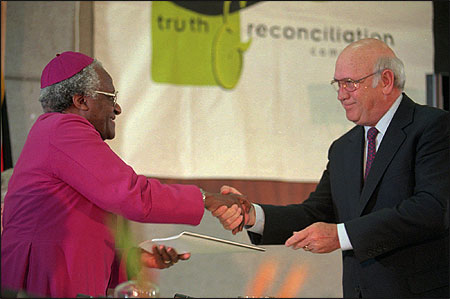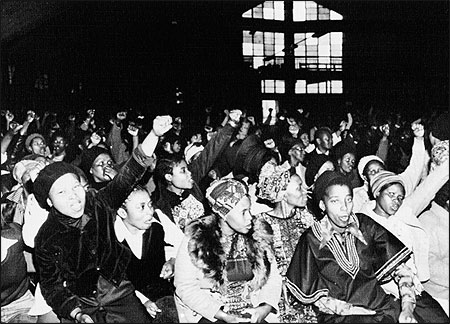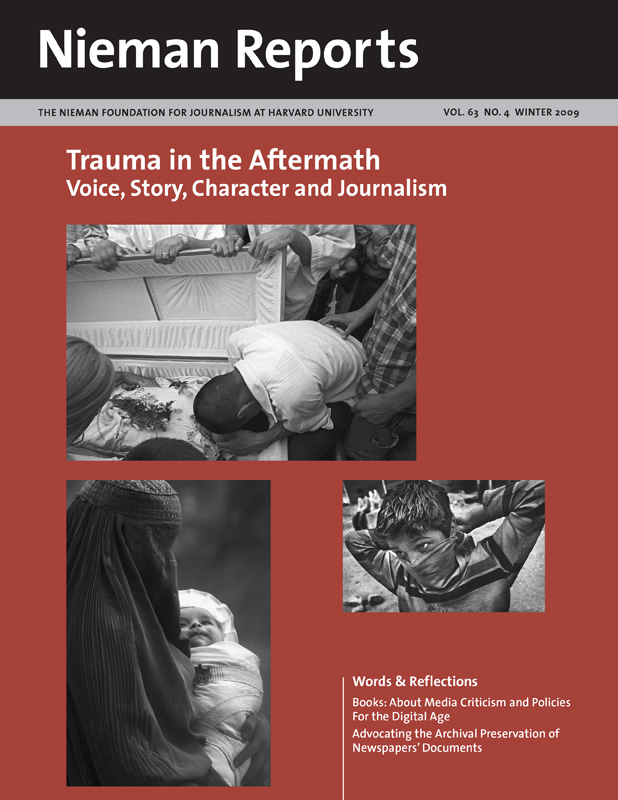
A quarter of a century ago, truth commissions emerged as one of the vehicles of transitional justice after times of violence. In the mid-1990’s, the South African Truth and Reconciliation Commission (TRC) brought new approaches to the process: It gave individual amnesty to those who testified; it allowed victims of the opposite sides to testify during the same forum; and, its hearings were held in public.
Once it was decided that the TRC hearings would be held in public, then decisions about news media coverage of the proceedings had to be made. To enable as many South Africans as possible to keep up with the proceedings, the commission, as it noted in its final report, “judged radio the most effective communication medium.” It described its reasoning in this way: “Radio listenership figures far outstrip newspaper readership. In addition radio broadcasts penetrate all corners of the country in the home languages of the majority of South Africans … [also] for those who are not literate and for those in rural areas.”
The commission’s radio strategy was buttressed by efforts to make it work. Money was raised to support such coverage; a special room was allocated to radio journalists; feeds of the different translations (of various languages and dialects spoken in South Africa) were relayed to radio journalists, and special phone lines were installed so that reports with quality sound could be fed straight to the news desk and to current affairs shows.
The Role of Journalists
I covered for radio the drafting of the TRC’s legislation in parliament. When the South African Broadcasting Corporation set out to create a team to report on the commission’s work, I was chosen to direct it. Our team adopted a multi-pronged approach using hourly news bulletins, longer news packages, Q. and A.’s, debates and analysis. At first we used this variety of genres to satisfy our need to understand events or behaviors, but over time this approach also prevented listeners from being bombarded with terrible facts of pain and suffering without any attempt made to find ways to process what they were hearing. We focused on concepts such as memory loss, post-traumatic stress symptoms, and anomie.
There was value in this core reporting group. We developed an institutional memory so we could immediately pick up any change in the process of testimony. More importantly, we could identify silences. We didn’t think that we should fill the silences, but we tried to analyze why they were there.
I only forbade members of our reporting team from doing one thing: initiating, looking for, or broadcasting a “live” reconciliation story. Reconciliation was immensely important and personal. I didn’t believe we had a right to witness it because our mere presence could interfere with and influence the process in a way that it perhaps didn’t really want to go. Individuals dealing with their pasts were always more important than a journalist’s story. Sensitive issues such as forgiveness or revenge should never be manipulated because one wanted a good story. I was and still am hugely suspicious of people who confront victims with questions about forgiveness.
The journalists’ devotion to this story, evident in their reporting on the TRC, showed that they felt involved in a process that was not simply a story; it resonated with and affected their lives. We reported this story because we wanted a better country and we wanted the effects of past injustice to come to light. If one wants a better society, a more caring and fair society, then targeting particular people as enemies or presenting some people as the devil isn’t productive.
I once watched the BBC’s reporting about Serbia’s Slobodan Milosevic at the International Criminal Tribunal for the former Yugoslavia in The Hague. The camera, which must have been below him, showed his face looking bloated and arrogant, and he was not speaking in English so BBC viewers couldn’t understand what he was saying. I wondered how he would have been reported on if he’d been on trial in his own country. Ultimately, how we reported on P.W. Botha and Joe Mamasela indicated to South Africans the level of injustice and arrogance we were prepared to live with and forgive. There is no point in letting foreign journalists report on a country’s own quest for righteousness. It is crucial for reporters from that country to do it themselves, to learn the vocabulary of right and wrong and the treachery of painting a person as “the Devil,” and therefore the bearer of guilt so that you become “the Angel,’’ the blameless.

Lessons Learned
The news media play a crucial part in any open process of discovering gross violations of human rights. I’d like to summarize some recommendations of dos and don’ts for radio coverage, based on lessons we learned during our coverage of TRC:
- Those involved in operating a TRC should be convinced about the importance of mother-tongue expression and translation through simultaneous interpretation.
- Radio reporters should strengthen their vocabularies in terms of how to convey information about traumatizing events and human rights. Learn or work with lexicographers to create the correct indigenous terms for human rights, indemnity, amnesty, rape, misogyny, masochism and other words that surface during the commission hearings.
- Do preparatory work on underlying concepts and founding legislation before a TRC begins its work. Listeners should know why the commission was established and what it will try to achieve. (Despite the fact that the South African TRC became famous for its individualization of amnesty, the African National Congress applied for general amnesty nine months into the process. Distribution of basic information clearly didn’t reach the upper echelons of the new government.)
- A core team of journalists should be kept on the story so that knowledge of the process can be developed and journalists can begin to trust their own judgments instead of being dependent on the information fed by the TRC or other stakeholders.
Keeping the integrity of the narratives is critical. We observed that the terminology, rhythm, pace and nonverbal signs of the victims’ narratives could seldom be improved upon.
Once I wrote a bulletin about a mother who talked about a T-shirt that was so full of bullet holes that it looked as if it was “eaten by rats.” The news bulletin editor thought it OK to change it to a “bullet ridden T-shirt.”
Another time I came across white people who were questioning the honesty of victims. “They waited until the camera was on them, then they cried,” they said. Working as closely as I was with the testimonies, I was astonished that anybody could reach this conclusion. Scrutinizing TV news coverage suggested why they had. The TV news coverage was often done by a local news reporter from the area. The result was that the news bulletin would open with an attractive, well-groomed young reporter standing in front of the building where the TRC had its hearings: “Today Mrs. So-and-so described how her son was killed by security forces …” Then, slap-bam and the camera was directly on this woman who was incoherent with grief. It truly did not seem real.
With our radio reports of testimony, we always used a structure in which a person’s actual words could be embedded. In other words, a radio story would not switch from the reporter to the victim but from the reported words of the victim to the victim herself. By the time the victim’s voice entered the story, her own words had prepared the listener.
Antjie Krog headed the radio team that covered South Africa’s Truth and Reconciliation Commission for the country’s public broadcaster.



